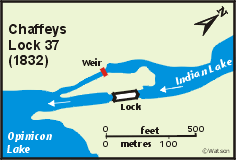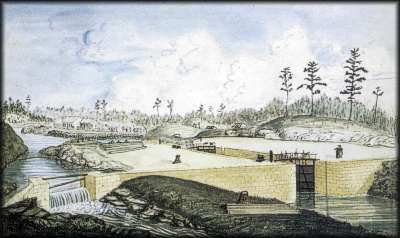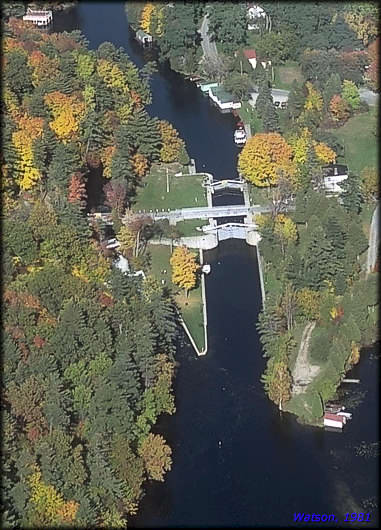Chaffeys Lock 37
| location map | lockstation information |
The Setting
Chaffey's Rapids were 333 yards (304 m) in length, descending about 13 feet (4 m) over that distance. These rapids were located where Indian Lake flowed into Opinicon Lake. A 1,500 yard (1,370 m) portage was located on the west side of the rapids. Samuel Chaffey settled here in about 1820 and by 1826 had a grist and carding mill on one bank of the river, and a sawmill and distillery on the other. He placed a mill dam upstream of his mills which regulated the level of Indian, Clear and Mud [Newboro] lakes.
The Plan
Samuel Clowes' plan in 1824 was to stay in the channel at Chaffey's Mills and raise the water level though the use of two detached locks. Clowes' planned route from Chaffeys to Newboro was through the west end of Indian Lake, through Mosquito Lake and then around the west end of Scott Island to Newboro Lake.
By decided to take the shorter route from Newboro to Chaffeys and cut a 110 yard (101 m) channel between Clear Lake and Indian Lake to allow navigation to proceed on a more direct course between Chaffeys and Newboro.
The Chaffey's Mills area itself proved more of a problem. Mactaggart in his 1827 survey sums it up quite well:
"Having passed Rideau Lake, Mud, Clear and Indian Lakes, we come to Chaffey's Mills, a very extensive establishment, consisting of saw, grist, and fulling-mills, carding-machines, stores, barns, distillery, &c. filling up the whole river, and not to be estimated at a less expense than 5000l. On first examining this place, I thought to have found no difficulty in passing the mills with the Canal, as a valley on the east side of the river seemed to set the matter at rest. But, in exploring this valley, nothing was found but deep rocky excavation, and it appeared that, after all, it would lead the Canal through woods and swamps two miles about; these were sufficient causes for a relinquishment of that route. The river was most carefully examined on its western side, with even worse success. A place was discovered below the mills, where a dam could easily be put, and two locks, sufficient for overcoming the whole rapids, of 13 feet, deepening the river above, raising the level of the lakes, &c.; but by this course the great mill establishment became drowned. Under these circumstances, I am not ashamed to own that I was more puzzled to know how to act, than on any other part of the route. High banks on either side of a river, and mills choking up that river, seemed to defy the science of engineering to pass them with the Canal, unless by running matters to a great expense. But, after taking the following measurements, levels, &c. and pondering on the subject, I came at last to a conclusion. Nine and a quarter feet was found to be the fall of Chaffey's Mill-dam, and the remainder of Rapid 3 feet 9 3/4 inches, beneath the mill-dam - where this Rapid began below it, was 1136 feet from the mill- bridge; length of the bridge 91 feet. On going to the bottom of the rapids, it was found that a break took place in the rocky bank, in which a lock might be advantageously built; and this lock might be 6-feet lift, without injuring the mills in any respect, farther than obliging the millers to lift their small horizontal wheels about 14 inches - a thing of no great trouble. By placing a lock here, it was found that the mills might be passed, by a trifling cutting of 10 feet. The dam for this lock requires to be 60 feet wide. Beneath the lock, the river will have to be deepened 2 feet for 150 feet; the bottom is rocky. Where the Canal takes the river again, above the mills, a lock of 11 feet 2 inches is required, and a dam 65 feet long across the river, so as to raise it 5 feet, on a level with the Rideau Lake, and to deepen the fords between. The stone abounding at Chaffey's Mills is of a singular nature, resembling white granite, but it is a species of limestone."
By's original plan was essentially as Mactaggart describes above, to construct a stone arch overflow dam above the mills and run a canal cut around the mills to avoid disturbing them. Two locks would be placed in the cut. The concept of adding a second dam to flood the foot of the rapids as suggested by Mactaggart was abandoned when it was determined that the lock and dam at Davis' Mills would raise the water to a sufficient navigation depth.
The tender for work released in early 1827 read; "To construct a Dam and two Locks at Chaffey's Mills. The Dam to be 20 feet high and 80 feet wide, the locks 9 feet lift each."

Original 2 lock proposal for Chaffeys
This 1827 map shows the original plan for Chaffeys.
“Locks and Dams at Chaffer's Mills. Section 15”, dated October 25, 1827, Library and Archives Canada, NMC 21879.
|
In 1827, Samuel Chaffey died of malaria and sometime after that Colonel By tried to buy out the milling operation in order to build the lock and weir. However, an ownership dispute between Samuel’s widow Mary Ann and his brother Benjamin prevented settlement. It wasn’t until October 1829, after Mary Ann and Benjamin had resolved their dispute, the Colonel By was able to purchase the mills and land for £2,000. This allowed By to move his canal works into the main channel, eliminating the need for the dam, although it added a waste weir. By also found that he could reduce the number of locks down to one. In his 1830 report By stated: "Prior to commencing the Works I directed further Levels to be taken when it was ascertained that by Deepening the Bed of the River, and cutting off some Rocky points, the Rise to be surmounted might be reduced to 12 feet 6 inches, I therefore considered, that by constructing a Waste Weir in such a manner as would enable the Water in the Lakes to be duly regulated, two Locks would not be required but that one of 12 ½ feet Lift might be placed in the Channel of the River with perfect security …."
Building the Locks
 The contract was awarded to John Sheriff & Co. Sheriff's partner was John Haggart, a stonemason and miller from Perth. During construction, Chaffeys was better known as Haggart's Job, "as under the management of a jolly bachelor of that name, well known for convivial hospitality to all travellers by this route." The contract was awarded to John Sheriff & Co. Sheriff's partner was John Haggart, a stonemason and miller from Perth. During construction, Chaffeys was better known as Haggart's Job, "as under the management of a jolly bachelor of that name, well known for convivial hospitality to all travellers by this route."
Stone for the building of the lock and weir could not be found locally and it had to be brought in from Halladay's quarry, near Elgin, 8 miles (13 km) away. The biggest problem here wasn't the construction of the lock and weir, it was malaria, which first struck with a vengeance in the hot summer of 1828, laying most of the crew low. John Sheriff and several labourers died as result of this round of malaria.
With the addition of the lock at the Isthmus (Newboro), By found he could lower the lift of the lock at Chaffeys to 10 feet 2 inches (3.1 m). The lock was positioned in the main channel, just a little bit downstream from the original mills, which were torn down to make way for construction. A 6 foot 6 inch (2.0 m) guard was placed on the lock to prevent it from being overflowed in spring flood. The floor of the lock was left as bare bedrock.
The weir was positioned in a rocky snie (dry flood channel) passing to the west of the main channel. It was built of masonry, in line with the lower lock gate, and incorporated bays (slots) into which stop logs could be dropped to regulate the flow of water through the weir.
 |
Lock, Waste Weir &c at Chaffey's Mills, Sketched 1833
Thomas Burrowes, watercolour over pencil, Archives of Ontario
The painting shows the lock in the middle of the channel, with the waste weir on the left side. Stop logs, which regulate the flow through the weir, can be seen above the weir. |
Through the Years
In 1844, a one storey masonry, defensible lockmaster's house was built. In 1894-95 the house was completely renovated and a wood frame back kitchen and second storey were added. The lockmaster's house is now a museum run by the Chaffey's Lock and Area Heritage Society.
This lock required very little maintenance in its first 70 years. The only major construction was the rebuilding in 1902-03 of the upper wing wall with stone from the quarry in Elgin.
The first bridge across the lock was a kingpost truss wooden swing bridge installed in 1884. It was repaired over the years and replaced in 1949 by a steel through plate girder swing bridge. That bridge was replaced by one of a similar design in 2015.
The old gristmill, located beside the waste weir at Chaffeys Lock, was built in 1872 by John Chaffey (a nephew of Samuel Chaffey). It was originally built entirely of stone, but a spring flood in about 1904 damaged the outer corner of the building and it was repaired with wood. In 1941 it was purchased by Arthur Phelps who had the building renovated as a private residence and put on a new roof.
The grand looking Opinicon Hotel started out in about 1899 when Lockmaster William Fleming acquired the property and built a tourist lodge. In about 1902, William Laishley bought the property, added a wing to the building and called it Idylwild. He operated it as a tourist resort until 1904 when he sold it a fishing club from Youngstown, Ohio, who operated it as a private club known as the “Opinicon Club”. In 1921 it was purchased by Mae and William Phillips of Pittsburgh who turned it back into a public tourist resort. It stayed in the hands of Phillips' descendants until was put up for sale in 2014. In January 2015 it was purchased by Fiona McKean and Tobi Lütke who are restoring it to its former glory.
 |
Chaffeys Lock
photo by: Pat Watson, 1981
An aerial view of Chaffey’s. The swing bridge is closed across the lower end of the lock. Barely visible on the left side is the waste weir. |
The Lockmasters to 2000
The first lockmaster was William Fleming, a Private in the 7th Company, Royal Sappers and Miners, and recommended for the position by Colonel By (shown as an "acting Corporal" on Colonel By's recommendation, but listed as a Private on the Sappers and Miners discharge list). Fleming retired in 1856 and was replaced in 1857 by James Simmons Jr. who served there until his retirement in 1894. The new lockmaster was Henry Fleming, a grandson of the first lockmaster and formerly a canalman at Davis Lock. Fleming was dismissed in December 1896, likely on the grounds of patronage, and rehired in the spring of 1897. He continued to serve as lockmaster until his retirement in 1929. Fleming was succeeded by Herman Warren who served as lockmaster until his retirement in about 1956. His replacement was William McIntyre who served as lockmaster until his death in 1967. Merle Forbes was acting lockmaster for part of 1967. He was followed by Hayward Warren from 1968 to 1982; Allan Blair from 1982 to 1984 and Vince Watters from 1985 to 2000.
|